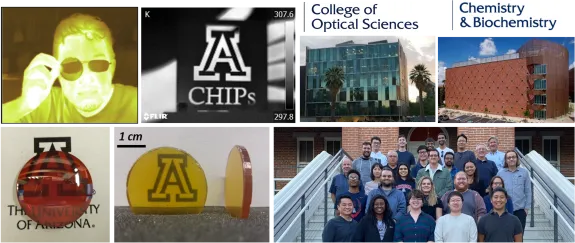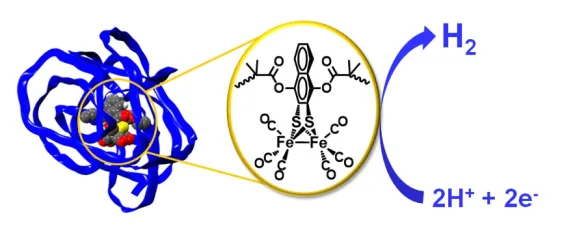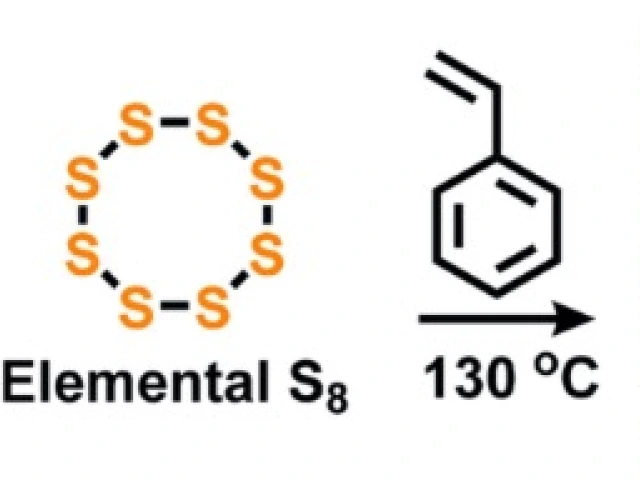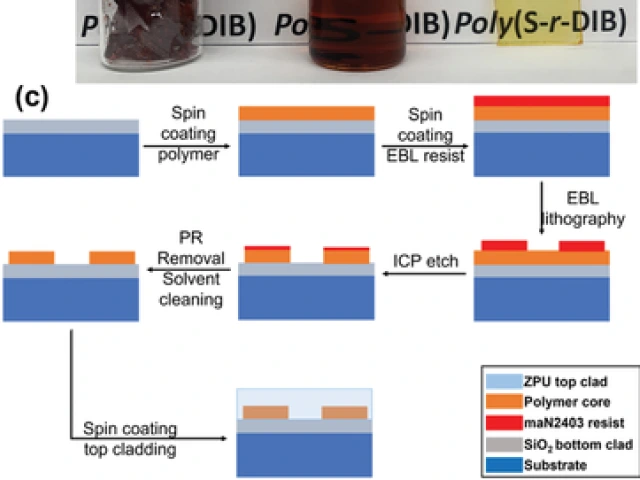Our research program is focused on the new synthetic polymer chemistry and development of advanced polymeric materials and nanocomposites. The Pyun group is an international renown group for developments in organic/inorganic hybrid polymers and materials for wide range of applications in photonics, energy, sustainability and defense (Nature Chemistry 2013, Advanced Materials 2014, Angewandte Chemie 2018, JACS 2022). We are a well-funded research program sponsored by US government agencies (National Science Foundation, Department of Defense, NIH, DOE) and numerous industrials partners.
Active Projects
Elemental Sulfur
A novel, abundant feedstock for polymers and nanocomposite materials
We have pioneered the utilization of elemental sulfur for novel polymers and nanocomposites. Sulfur is commonly used as a vulcanizing agent in the crosslinking of rubber for tires, however the use of elemental sulfur as the primary monomer, or comonomer for polymeric materials has not been widely explored. Elemental sulfur is currently produced on the level of 70 million tons annually, the majority of which is thru hydrodesulfurization of crude petroleum. Consequently, over 6 million tons of elemental sulfur is generated in excess, which creates exciting opportunities to develop new chemistry and processing to utilize sulfur as a feedstock for polymers. We have invented a new polymerization process, termed, inverse vulcanization, to directly convert elemental sulfur into high sulfur content polymers (Nature Chemistry 2013), which has since launched this technology as a new field in polymer science. Sulfur exhibits a number of useful properties, such as, high charge capacity for Li-insertion electrochemistry and high refractive index. However, the chemical modification of sulfur into useful materials remains a difficult technical challenge. Toward this end, we are developing new polymerization and processing methods for the direct utilization of sulfur to prepare thermosetting polymeric sulfur and nanocomposite materials.
Key publications:
Pyun, et al. Nature Chemistry 2013, 5, 518-524; ACS MacroLett. 2014, 3, 229; Prog. Polym. Sci. 2016, 58, 90; J. Polym. Sci., Part A: Polym. Chem. 2017, 55, 1635; Polym. Chem. 2019, 10, 4078; Angew. Chem. Int. Ed. 2021, 60, 22900; JACS 2022, 144, 5.

High refractive index polymers for infrared optics and photonics
We have pioneered the development of ultra-high refractive polymers derived from the inverse vulcanization of elemental sulfur as the first class of optical polymers for infrared imaging and IR photonics. These polymers are termed, Chalcogenide Hybrid Inorganic/Organic Polymers (CHIPs) as a hybrid from elemental chalcogenides, such as, sulfur, selenium with organic comonomers.
We have a diverse and highly collaborative research term at the interface of synthetic organic chemistry, polymer chemistry, computational chemistry and optical sciences to prepare novel optical polymers and fabrication of these materials into plastic optics and photonic devices.
We have been recently awarded multi-PI grant for using computational chemistry thru the NSF and AFRL DMREF program to accelerate development of new IR polymers (~$2M USD for 4-yrs)
Key publications:
Pyun, J. Adv. Mater. 2014, 26, 3014; ACS Macro Letters, 2015, 4, 862; ACS Macro Lett. 2016, 5, 1152; ACS Macro Lett. 2017, 6, 500; ACS Macro Lett. 2018, 7, 875; Angew. Chem. Int. Ed.. 2019, 58, 17656; ACS Macro Lett. 2020, 9, 245; Science Advances 2020, 6, eabb5320; Adv. Opt. Mater. 2022, 10, 2200176.

Artificial Enzymes for Catalytic Water-Splitting for Clean Hydrogen Production
Diiron disulfide metallopolymers prepared by atom transfer radical polymerization (ATRP)
Metal-containing polymers can combine the useful properties of polymers with the key functions of metal complexes. These metallopolymers are applicable to a wide range of areas such as photovoltaics, stimuli responsive materials and catalysis. Catalysis, for example, includes designing artificial metalloenzymes which can mimic the biological functionalities by engineering the environment of a metal complex using polymeric materials. FeFe-hydrogenase enzyme found in bacteria is an efficient H2 generation catalyst and there has been extensive research on making FeFe-H2ase mimics to produce H2 as a carbon-free energy carrier. The mimics have shown high catalytic activities in organic media, however, limited lifetime, low oxygen stability and low solubility preclude the applicability of the mimics. We, for the first time, made a metalloinitiator from a FeFe-H2ase mimic to grow polymers via ATRP. The polymers not only provide water solubility and oxygen stability in neutral water but also enhance the activity of the complex by tuning the secondary coordination sphere of the mimic. We will discuss our most recent efforts to synthesize a difunctional metalloinitiator and metallopolymers grafted via ATRP.
Key publications:
Pyun et al., Proceedings of the National Academy of Sciences 2020, 117, 32947; Macromol. Rapid Commun. 2020, 41, 1900424; Angew. Chem. Int. Ed. 2019, 58, 7537; ACS Macro Lett. 2018, 7, 1383; Angew. Chem. Int. Ed.. 2018, 57, 11898.

Refractive Index Contrast Polymers: Photoresists for polymer waveguides, interconnects & photonic devices
We have developed a new class of optical polymers, termed, Refractive Index Contrast (RIC) Polymers, which are a class of photoresists that can be used as a “dry-write” film for waveguide and optical interconnect fabrication. These new optical polymers are designed to enable rapid device component integration of photonic devices for next generation semiconductor chip fabrication.
Key publications:
Pyun et al., ACS Macro Lett. 2020, 9, 416; J. Lightwave Technol. 2022, 40, 3839; Optics Materials Express 2022, 12, 1932.

Polymer & Inorganic Nanoparticle Materials
Our research program is focused on the synthesis and characterization of novel polymeric and inorganic metal, semiconductor and magnetic nanoparticles, with an emphasis on the control of nanoscale structure. Recent developments in polymer and colloid chemistry offer the synthetic chemist a wide range of tools to prepare well-defined, highly functional building blocks. We seek to synthesize complex materials from a "bottom up" approach via the organization of molecules, polymers and nanoparticles into ordered assemblies.
Control of structure on the molecular, nano- and macroscopic regimes offers the possibility of designing specific properties into materials that are otherwise inaccessible. We are particularly interested in compatabilizing interfaces between organic and inorganic matter as a route to combine the advantageous properties of both components. This research is highly interdisciplinary bridging the areas of physics, engineering and materials science with creative synthetic chemistry.
We are using these synthetic techniques & processing methods to prepare nanomaterials for applications in magneto-optical materials for Faraday Rotation, energy and magneto-responsive materials
Key publications:
Pyun et al., Chem. Mater. 2022, 34, 2531; Chem. Mater. 2021, 33, 5010; J. Mater. Chem. C. 2020, 8, 5417; Angew. Chem. Int. Ed. 2016, 55(5), 1787; ACS Nano 2015, 9, 4591; Prog. Polym. Sci. 2015, 40, 85; ACS Nano 2014, 8, 3272; ACS Nano 2012, 6, 8632; Chem. Mater. 2011, 23, 1120; J. Am. Chem. Soc. 2010, 132, 3234; ACS Nano 2009, 3 (10), 3143; ACS Nano 2007, 4, 279; J. Am. Chem. Soc. 2007, 129, 6291; J. Am. Chem. Soc. 2006, 128, 6562.





